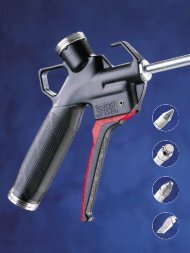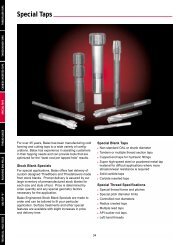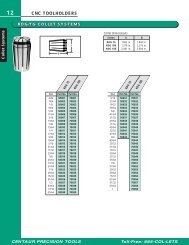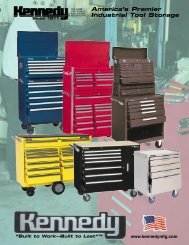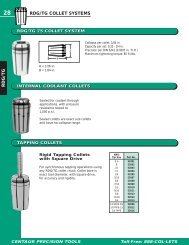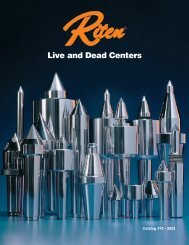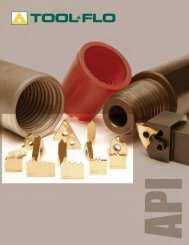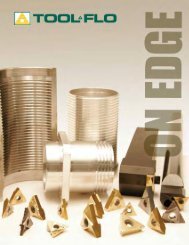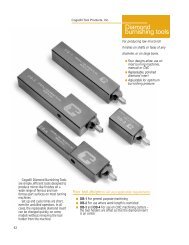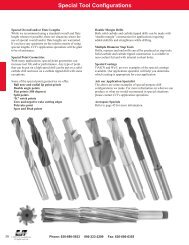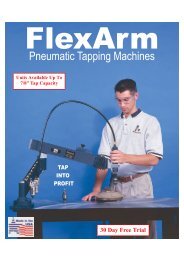Silencers
Silencers
Silencers
Create successful ePaper yourself
Turn your PDF publications into a flip-book with our unique Google optimized e-Paper software.
<strong>Silencers</strong>The risk of disruption as a result of a cloggedsilencer is eliminated with Silvent silencers.How to choose the right silencer4.24.24.34.44.54.64.7Loud exhaust noise from pneumatic valvesThree standard types of Silvent silencersSingle or multiple valvesDimensioning guidelinesHow to get rid of oil mistLarge flows and short cyclesSpecial requirementsProducts4.84.94.104.124.144.15Hose silencersCentral silencersCentral silencers with oil separationExpansion silencersCoupling assembly examplesCoupling components4.1
Loud exhaust noise from pneumatic valvesNoise from pneumatic valves is far more dangerous andresults in considerably more permanent hearing impairmentthan most people realize. The human brain is incapableof registering the actual strength of the rapidchain of events the ear is exposed to. The strength andharmfulness of impulse noise, e.g. compressed air noiseor hammering noise, is frequently underestimated.A half–inch valve that regulates a pneumatic cylindermaking three strokes per minute generates a noise levelas high as a continuous noise source of 92 dB(A).Working on a daily basis in such an acoustic environmentis directly injurious.Fortunately, noise of this type is, for the most part,avoidable. With the right technique, compressed airnoise can virtually be eliminated.Silvent silencers effectively muffle the noise of exhaustair from one or several valves.LevelPeak valueEquivalentnoise levelImpulseTimeImpulse noise is too rapid for the brain tofully register. It generates a high equivalentnoise level that corresponds to a continuousnoise level which is clearly sufficient to permanentlyimpair hearing.Three standard typesof Silvent silencersHose silencersFor installation directly in the valve’s exhaustports. Provides noise reduction of approx.25 dB(A).Central silencersDesigned to muffle the noise of exhaust airfrom a large single valve or as a commonsilencer for a number of smaller valves.Provides noise reduction of 30-34 dB(A).Expansion silencersUsed in systems with short cycles requiringlow backpressure. Provides noise reductionof 30-35 dB(A).4.2 www.silvent.com
Single or multiple valvesSingle valvesWhen noise is generated by a single valve, goodresults are normally attained by using an SDR or SDVhose silencer. This type of silencer is suitable for valveswith connection diameters of Ø 1/8” or Ø 1/4".Whether you should choose a straight hose silencer(SDR) or an angled hose silencer (SDV) is primarily aquestion of available space. The choice also dependson the orientation of the valve’s exhaust ports.If you need as little pressure drop as possible across thesilencer, you should choose an SDR. Consult the tableon the following page to make sure you have not selecteda silencer that is too small.In most cases it is simply amatter of choosing a silencerwith the same thread as theexhaust ports of the valve.Several valvesWhen noise is generated by many valves, the best solutionis to connect the exhaust ports to a central silencer(CD). Of course you can also use hose silencers if thesize of the valve so permits.The solution of connecting several valves together providesan installation that is well adapted to its purpose. Thecentral silencer can be positioned so that the degree ofnoise reduction is maximized. The centralized placementof the silencer also facilitates maintenance since manyvalves can be serviced from a single point. Comparethis with the ordinary, conventional solution where youuse two silencers per valve.The installation of a central silencer saves both time andmoney when it comes to maintenance.The OPUS central silencersystem lowers the costsfor service and maintenanceto a minimum.Many machines have a large number of valves that arecontrolled by block-mounted valves. It is rare that severalof the cylinders operate simultaneously. Therefore youcan connect a large number of valves to a single silencer.You can connect up to 10 1/4” valves. If a sensitivevalve leads to malfunction, it should be connected to asilencer of its own.A CD is dimensioned to handle the flow from a 1/2”valve operating at short intervals.www.silvent.com4.3
Dimensioning guidelinesThe table below provides recommendations on thetypes of silencers that are appropriate for various typesof pneumatic systems.Q Nm 3 /hOPERATING PRESSURE 500 500 kPa kPaCylinderØ3232404050506380100125160200>200>200Valvedim.1/81/81/41/41/41/43/83/81/21/23/43/411Max. pistonspeed m/s0.601.000.741.000.601.001.001.001.000.931.000.700.500.50SilencerSDV 18SDR 18SDV 14SDR 14SDV 14SDR 14CD/CDOCD/CDOCD/CDOCD/CDOED 1023ED 1023ED 1023ED 1023Noise reductiondB(A)25252525252534343434313131291000500200100502010Ø 320Ø 250Ø 200Ø 160Ø 125Ø 100Ø 80Ø 63Ø 50Ø 40Ø 32ED 2033ED 1023CD/CDOSDR 14SDV 14SDR 18SDV 18The term piston speed refers to the average speed for a single stroke.Stroke length (m)Piston speed (m/s) =Time for a single stroke (sec.)5210 0,1 0,2 0,3 0,4 0,5 0,6 0,7 0,8 0,9 1,0V m/sExample: Cylinder Ø 125 with apiston speed of 0.25 m/srequires a CD or CDO silencer.Another method for choosing the proper silenceris using the diagram above. By knowing thediameter of the cylinder and the speed of thepiston in m/s you can find the intersection pointin the diagram. The maximum capacity for thevarious silencers is indicated by the dotted horizontallines. <strong>Silencers</strong> whose lines lie higherthan the point of intersection can be used.4.4 www.silvent.com
How to get rid of oil mistMost pneumatic systems contain apparatus for mist lubrication,which mixes oil droplets into the compressed airto lubricate moving parts in valves and cylinders. Whenthe entrained oil has served its purpose, it passes throughthe valve’s exhaust ports into the workplace.Due to the fact that the velocity of the air passing throughthe exhaust port is exceptionally high, the oil is dispersedas extremely fine, suspended particles, creating oil mist.In highly automated installations with many lubricatedpneumatic valves, the amount of oil mist generated bythe pneumatic system may well be high enough to causediscomfort. This may be the case even though oil mistlevels are substantially below those permitted by nationalhealth authorities.To come to grips with the problem of oil mist in theworkplace, a central silencer with an oil trap (CDO)should be installed.The CDO utilizes two separation principles: first, amechanical oil trap that takes care of most of the oil;second, a filter that causes the remainder of the oil toform globules.The degree of separation achieved by a Silvent centralsilencer has been measured at 99%.This degree of separation is entirely adequate – no extremeseparation to no practical use.When determining the number of CDOs needed for a giveninstallation, you can use the same guidelines as for the CD.The table on page 4.4 applies to the CDO as well.The CDO should be complemented with a collection vesselfor the oil.HOSE CONNECTIONHose connectionOil OIL trap TRAPDiffusion DIFFUSION plate PLATEFILTERS FiltersMechanical oil trapAs the mixture of air and oil mistpasses the valve’s exhaust port, itexpands and cools rapidly, condensingthe oil on the inner wall of the hose.Outlet OUTLETConnection pipeGlobules of oil and some spill airpass along the wall of the oil trapand are collected in a separate vessel.CDO with collectionvessel UKMost of the airflow goes on to thesilencer.www.silvent.com4.5
Large flows and short cyclesIf you have large cylindersWhen silencing valves that create especially strongimpulse flows (large volumes for a short time), it isimportant that there is volume between the valve andthe silencer to even out the pulse. Normally, hoses andcoupling manifolds provide the desired volume.However, for special cases with exceptionally largeflows, the expansion silencer has been developed.Expansion silencers are available for connections withdiameters of up to Ø 2”.Use the table on page 4.4 to decide which silenceryou should install.Expansion silencers are particularly suitable for systemswith the following characteristics:• Large flows• Short cycles• Sensitivity to backpressureIf you have quick evacuation valvesTo attain faster cylinder function, quick evacuation valvesare sometimes used. As a rule, these valves generatelarger flows than ordinary valves of the same connectiondimension. Therefore, when connecting valves to asilencer, it is advisable to watch for reduced cylinderspeed or overloading of the silencer.It may be necessary to increase the number of silencersand mount them in parallel.If you have punch pressesMany punch presses are equipped with so called pneumaticengagement. After a punch stroke has been initiated,the engagement mechanism is evacuated in order tostop the punch. If evacuation is impeded, there is a riskof double punching. For this reason, modern silencersmust be fitted with a relief valve that opens if backpressureshould become too great.To achieve satisfactory noise suppression, exhaust shouldbe connected to an expansion tank whose volume is 5 to10 times that of the engagement mechanism. Air fromthe expansion tank is then discharged to one or severalcentral silencers, depending on the size of the press.4.6 www.silvent.com
For special requirementsIf you have air motors or hand toolsExhaust air from air motors in, for example, hand-heldtools such as grinding machines and nut setters oftenposes a noise problem. Since the power of an air motoris a function of the pressure differential across the motor,backpressure on the discharge side is necessarily negative.Therefore, silencing used in such applications mustallow relatively free air passage.Our range of silencers has been developed primarily forstationary installations of cylinders and valves.Tests have shown that hose silencers can often be usedwith highly satisfactory results. On the whole, however,the results of the tests have varied so greatly that it is difficultto provide general dimensioning guidelines.You should begin with a simple test installation andbase further dimensioning upon the results of the trial.The maximum amount of continuous flow the differentsilencers are capable of handling is shown in the diagramon page 4.4.If you have a vacuum system with air ejectorsPneumatic ejectors are even more sensitive to backpressurethan air motors. Extreme care must be taken in suchinstallations. Our central silencer CD may however beused in most cases.The maximum amount of continuous flow the differentsilencers are capable of handling is shown in the diagramon page 4.4.Silvent can help with thisWe gladly provide tips and recommendations on thesilencers that are most suitable for your purposes. Wecan also help by tailoring silencers for special applicationswhere a stock model might not be sufficiently effective.We can assist you in figuring out which additional partsyou will need. Our product range includes manifoldsand various couplings and connection parts for problemfreeinstallation.The advantage of taking measures nowYou avoid further risk of experiencing production stoppagedue to clogged silencers.The problem of noise from pneumatic valves is solvedonce and for all.If you choose a silencer with an oil trap, you can getrid of oil mist in the workplace at the same time.www.silvent.com4.7
HOSE SILENCERSDOPUS hose silencers are designed to be mounted directley in the exhaustports of the valve. They are available in two sizes, 1/8” and 1/4”, bothwith either straight or angled connections.The patented OPUS hose silencer provides noise reduction of 20-25dB(A).These hose silencers afford considerable advantages in comparison withcompeting products constructed of sintered metal or plastic. Besides providingmore effective noise suppression, hose silencers can not clog. Aclogged silencer in a compressed air system often results in an interruptionof service, the cause of which can be extremely difficult to locate.Moreover, with sinter silencers, there is clearly a risk of explosion. Thedesign of OPUS hose silencers eliminates both the risk of accident and disruptionof service.CONSTRUCTIONThe flexible absorber in the OPUS hose silencer stretches with each blastof air, thereby allowing dirt and ice to pass unhindered. The OPUS hosesilencer cannot possibly clog.The picture above shows a pneumatic press where hose silencers haveeffectively eliminated impulse noise.NOISE REDUCTIONORDERING INFORMATIONdB(A) 1001/4” valveCylinder Ø40 (1 1/2”), l=200 (8”)1001/8” valveCylinder Ø32 (1 1/4”), l=200 (8”)LL90807019259080701425GNHGNSnap-on nut nutSPECIFICATIONSSilencerMax. op. pressureMax. op. temp.UnsilencedportSintersilencerkPapsi°C°FOPUSSDSDV 182003070°160°UnsilencedportSDR 182003070°160°SintersilencerSDV 142003070°160°OPUSSDSDR 142003070°160°ThreadStraight1/8”1/4”Angled1/8”1/4”Lmm “260 10.23330 12.99260 10.23330 12.99Hmm “14 0.5517 0.67Nmm “13 0.5117 0.6713 0.5117 0.67Order no.SDR 18SDR 14SDV 18SDV 14FlowNm 3 /hscfm10.96.4220.412.0226.115.3750.929.98Weightglbs160.035150.033340.075330.073MaterialPVC;PPPVC;PPPVC;PPPVC;PP4.8 www.silvent.com
CENTRAL SILENCERWhen a CD was installed at Scania in Södertälje, the machine was suddenlyso quiet that the company’s personnel thought there was something wrongwith the machine. Safety inspector Anders Rundgren confirmed that thenoise peaks were reduced from 105 dB(A) to 84 dB(A) by the installation.CDThe OPUS central silencer is designed to silence exhaust air froma single large valve or as a common silencer for a number ofsmaller valves.This silencer has been dimensioned to manage the flow from 1/2”valves operating at short intervals. In machines containing a largernumber of valves, the timing of the cycles is often irregular. Insuch systems, several valves can be connected to a centralsilencer.The patented OPUS central silencer provides a noise reduction of30-35 dB(A).The OPUS central silencer has a radically different constructionthan competing silencers. The larger silencers on the market areoften designed to lead air to the middle, to a central tube shapedfilter – a so called coalescence filter.The disadvantage of this construction is that, sooner or later, thefilter clogs, resulting in interruption of service. The most commonlyoccurring problems in pneumatic systems are, however, causedby diffusion silencers, or so called sinter silencers. Every day,clogged sinter silencers lead to thousands of unnecessary andexpensive disruptions and breakdowns in industries throughoutthe world. Furthermore, clogged sinter silencers involve an indisputablerisk of explosion.The design of the OPUS silencer eliminates the risk of disruptiondue to clogging (see page 4.11) as well as providing oil separationthat cleans exhaust air.Our central silencers are available in two models: CD and CDO.The essential difference between the two models is the degree ofoil separation. The CD silencer separates oil in the filter only, providingmore than adequate separation for most industrial environments.The CDO silencer is designed with a built-in oil trap aswell, for intensive oil separation. See the following page.NOISE SUPPRESSIONORDERING INFORMATIONdB(A) 10090801/2" 1/2” valve valveCylinder Ø100 (4”), l=100 (4”)Cylinder Ø 100 (4"), l=100 (4") 110(4.33")33(1.3")233470UnsilencedportSintersilencerOPUSSD CDØ 150(Ø 5.9")Ø 96(3.78")SPECIFICATIONSSilencerCD4 x Ø 5 (0.19")Max. op. pressureMax. op. temp.FlowkPapsi°C°FNm 3 /hscfm2003070°160°261154DescriptionCentral silencerRemarksComplete with filter, connection pipe,hose clamp and 0.5 m (19.7”)connection hose Ø 20/16 (SL16)Order no.CDWeightglbs3100.68MaterialsPolypropylene plastic, Fiberglass, Nitrile rubberwww.silvent.com4.9
CENTRAL SILENCER WITH OIL SEPARATIONThe OPUS central silencerCDO has the same capacityas the CD for noise supression,in addition to intensiveoil separation. This silencer isequipped with a built-in oiltrap, where oil is separatedfrom exhaust air and drained.The OPUS central silencerCDO reduces the amount ofCDO oil mist in exhaust air byapprox. 99%.Most pneumatic systems containapparatus for mist lubrication,which mixes oil mistinto the compressed air. Whenthe entrained oil has served itspurpose, it passes though thevalve’s exhaust ports into theworkplace.Aside from the practical disadvantagesthat grease and dirty oil involve, there are medicalconsiderations: health hazards associated with both inhalation ofand direct skin contact with oil.Hasselblad, the Swedish camera makers, have installed a number ofOPUS silencers in their production to eliminate oil mist and impulse noise.This picture shows a CNC machine fitted with a CDO for oil separation.Diffusion silencers of the sinter type actually exacerbate the problemof oil mist in the working environment. Oil droplets passingthrough the sintered material are diffused, thereby increasing theamount of oil mist in the air.The OPUS CDO reduces the amount of oil mist in exhaust air towell under existing limits; levels are so low that they are barelyperceptible using ordinary measuring equipment.OIL MIST FALLS INTO THE TRAPThere are two barriers for oil in the OPUS trap: first amechanical oil trap that takes care of the greater portionof the oil, then a filter that causes the remainder of the oilmist to form globules.As the mixture of air and oil mist passesthe valve´s exhaust port, it expands andcools rapidly, condensing the oil on theinner wall of the hose. The oil then runs indrop form into the silencer.SPECIFICATIONSSilencerMax. op. pressureOperating temp.FlowWeightkPapsi°C°FNm 3 /hscfmglbsCDO2003070°160°2611543250.72MaterialsPolypropylene plastic, Fiberglass, Nitrile rubbermg/m 3 3 110(4.33")33Most of the airflow goes(1.3")on to the silencer.Oil mist15content+9.9% +9,9%4 x Ø 5 (0.19")OIL SEPARATION10Connection pipe.Globules of oil and some spill air passalong the wall of the oil trap andare collected in a separate vessel.ORDERING INFORMATIONØ 150(Ø 5.9")Ø 96(3.78")150(5.9")51(2.01")UK65(2.56")77(3.03")2 x Ø 5(0.19")5DescriptionRemarksOrder no.UnsilencedportSintersilencer-99%OPUSCDOCentral silencerOil vesselComplete with filter, connection pipe,hose clamp and 0.5 m (19.7”)connection hose Ø 20/16 (SL16)Complete with mounting bracketCDOUK4.10 www.silvent.com
BUILT-IN PROTECTION AGAINST CLOGGINGFILTERS FiltersOUTLETOutletHose HOSE connection CONNECTIONOil OIL trapTRAPDiffusionDIFFUSIONplatePLATEThe cutaway diagram on the left shows how the OPUS centralsilencer is constructed.Noise is muffled as the compressed air passes through the soundabsorbing filters. The large surface area makes clogging highlyunlikely. Should routine filter change be overlooked and the outerfilter become blocked after an extended period of use, it is forcedout of the filter holder when back pressure becomes too great,allowing the air to pass.There is no interruption of service.It is recomended that filters be changed on a regular basis in connectionwith routine maintenance of the pneumatic system. Filterreplacement is both easy and inexpensive.Every silencer in the OPUS range provides built-in protectionagainst clogging.EASY INSTALLATION AND FILTER REPLACEMENTHOSE SL 16(Ø 20/16)CONNECTION PIPEAR 16HOSE CLAMPSK 20HOUSING CDFILTER FCDIFFUSERFILTER FAOPUS CD1. The OPUS CD can bemounted in any position.2. Press the hose onto theconnection pipe as far aspossible.3. Fit the connection pipefirmly into the silencer.4. Mount the hose clamp.FILTER HOLDERHose HOSE SL SL 06 06HOSE Hose SL SL 16 16(Ø 20/16)OPUS CDOWith three alternative outletsCONNECTION Connection pipe PIPE With three alternative outletsfor oil drainageAR 16for oil drainage.The OPUS CDO is mountedO-RING O-ringThe Opus CDO is mountedon a vertical surface. TheOR 17on a vertical surface. TheinletinletmustmustbebeturnedturnedupwardsupwardsHOSE Hose clamp CLAMP orortotooneoneside.side.SK 20Additional instructions forAdditional instructions forHousing HOUSING CD CDmounting and filter replacementas for the CD.mounting and filter replacementas for the CD.FILTER Filter FC FCO-ring O-RING OR OR 75 75DIFFUSER DiffuserFILTER Filter FA FAFILTER Filter holder HOLDERFILTER REPLACEMENTFILTER REPLACEMENTUnscrew the filter holder and replace filter FA. The filter should beplaced with the smooth side out. If filter FC needs replacement, theconnection pipe must be disassembled and the diffuser removed.Please note! The guide on the diffuser should fit in the groove inthe housing. OPUS ED 1023 and ED 2033, the largest silencersin the OPUS range, are fitted with the same size filters as the CD.Filter replacement as for the CD.DescriptionFilter FAFilter FCHD ØD ØDiameter (D)Ø 109 (4.29”)Ø 73 (2.87”)Height (H)20 (0.79”)35 (1.38”)Order no.FAFCwww.silvent.com4.11
EXPANSION SILENCER 1023ED 1023The OPUS expansion silencer ED 1023 is designed for noisesuppression and oil separation in systems with large air flows.The ED 1023 is dimensioned to handle the flow from cylinderswith large stroke volumes. This silencer is capable of managingexhaust air from several 1” valves operating at short intervals.Typical areas of application are machines with short cycles andrequirements for low backpressure. Such applications requirelarge expansion volumes to attain sufficiently quick pressure dropin the system. The ED 1023 is also suitable for use as a commonsilencer for entire groups of machines.The ED 1023 provides noise reduction of 30-35 dB(A).Here, an OPUS ED 1023 is connected to a folding machine with 2 x7 rubber bellows.The silencer has three 1” inlets and two drainage outlets for oilseparation. Oil separation is approximately 99%.As is the case with all OPUS silencers, the ED 1023 affords builtinprotection against clogging.NOISE REDUCTION/OIL SEPARATIONORDERING INFORMATIONdB(A) 100NOISE REDUCTION1” valveCylinder Ø200 (Ø8”), l=200 (8”)Oil mistcontentmg/m 315OIL SEPARATION410(16.14")350(13.78")901080315175(6.89")135(5.31")Ø 10(0.39")70UnsilencedportOPUSED 1023Unsilencedport-99%OPUSED 102330(1.18")20(0.79")15(0.59")SPECIFICATIONS205(8.07")SilencerMax. op. pressureMax. op. tempkPapsi°C°FED 10232003070°160°140(5.51")1/4" Ø8 (2x)(Ø 0.31")30 (1.18")118(4.65")175(6.89")1" (3x)10 (0.39")50(1.97")FlowWeightMaterialNm 3 /h490scfm288g3630lbs8Steel, Polypropylene, Fiberglass, Nitrile rubberDescriptionExpansion silencerOrder no.ED 10234.12 www.silvent.com
EXPANSION SILENCER 2033ED 2033The OPUS expansion silencer 2033 is designed for noise suppressionand oil separation in systems with extremely large flows.The ED 2033 is dimensioned to handle the flow from cylinderswith large stroke volumes. This silencer can manage exhaust airfrom several 2” valves operating at short intervals.Typical areas of application are machines with short cycles andrequirements for low backpressure. Such applications requirelarge expansion volumes to attain sufficiently quick pressure dropin the system. The ED 2033 is also suitable for use as a commonsilencer for entire groups of machines.The ED 2033 provides noise reduction of 30-35 dB(A).Using two ED 2033s SKF has solved a noise problem in a powder press.Connecting the silencers in series provided the expansion volume requiredto avoid backpressure in the system.The silencer has three 2” inlets and two drainage outlets for oilseparation. Oil separation is approximately 99%.As is the case with all OPUS silencers, the ED 2033 affords builtinprotection against clogging.NOISE REDUCTION/OIL SEPARATIONORDERING INFORMATIONNOISE REDUCTIONOIL SEPARATIONdB(A) 1002” valveCylinder Ø300 (12”), l=200 (8”)Oil mistcontentmg/m 315610(24")550(21.65")90108070295175(6.89")135(5.31")Ø 10(0.39")-99%UnsilencedportOPUSED 2033UnsilencedportOPUSED 203330(1.18")20(0.79")15(0.59")SPECIFICATIONSSilencerMax. op. pressureMax. op. tempFlowkPapsi°C°FNm 3 /hscfmED 20332003070°160°740436245(9.65")180(7.09")1/4" Ø8 (2x)(Ø 0.31")30 (1.18")213(8.39")138(5.43")2" (3x)6510 (0.39") (2.56")WeightMaterialg6750lbs15Steel, Polypropylene, Fiberglass, Nitrile rubberDescriptionExpansion silencerOrder no.ED 2033www.silvent.com4.13
COUPLING ASSEMBLIES FOR CENTRAL SILENCERSThe OPUS range includes a large number of fittings with which exhaust air from a number of valve portscan be brought to a common noise suppressor - a central silencer.STRAIGHT COUPLINGAvailable in many connectionsizes.Y-PIECEThe simplest method for joiningexhaust ports is by means of a Y-piece.The OPUS range includes a wide selectionof sizes.DUMMY PLUGFor closing off connections that are notused.ANGLE COUPLINGwith swivel connection. For maximum speedof assembly, the threaded part is a separateunit which is first screwed into the port beforethe angled section is snapped intoplace.HOSE CLAMPHOSE CLIPThe range also includes an assortmentof hose clamps and hose clips.REDUCERReducers increase combinationpossibilities.COUPLING MANIFOLDThe OPUS range contains a large numberof standard types.OPUS CENTRAL SILENCERNormally, 6-10 1/4” valves can be connected to asingle central silencer without risk of disruption. Inapplications involving large amounts of air and requiringlow backpressure, each valve should beconnected to its own central silencer. For extremelylarge air flows, an OPUS expansion silencer isrecommended.HOSEThe range includes hoses with a larger internaldimension than the hose on the delivery side: both asimple PVC hose of oil resistant quality and a reinforcedhose that is extra flexible and adaptable.ASSEMBLY EXAMPLES WITH Y-PIECECentral silencer connected to one valve.ASSEMBLY EXAMPLES WITH COUPLING MANIFOLDCentral silencer connected to several valves.Valve diam.1/4”3/8”1/2”3/4”Valve diam.1/8”1/4”3/8”1/2”3/4”CouplingRN 1412RN 3812RN 1216RN 3416CouplingRN 1810RN 1412RN 3812RN 1216RN 3416Hose clampHoseHose clipHose clampSK 10SL 12KK 12SK 10SK 10SL 12KK 12SK 10SK 16SL 16KK 16SK 18SK 16SL 16KK 16SK 18Hose clampHoseHose clipHose clampSK 04SL 10KK 10SK 04SK 10SL 12KK 12SK 10SK 10SL 12KK 12SK 10SK 16SL 16KK 16SK 16SK 16SL 16KK 16SK 16Y-piceHose L=30Y 12SL 12Y 12SL 12Y 16*–Y 16*–Dummy plug P 18Coupling RN 1810Coupl. manifold KR 18X1P 14RN 1412KR 14X1P 14RN 1412KR 14X1P 16–KR 16X1P 16–KR 16X1Hose clampHoseHose clipSK 16SL 16KK 16SK 16SL 16KK 16SK 18SL 16KK 16SK 18SL 16KK 16Hose clampHoseHose clipSK 16KK 16SL 16SK 16KK 16SL 16SK 16KK 16SL 16SK 16KK 16SL 16SK 16KK 16SL 16OPUS central silencer CD or CDOOPUS central silencer CD or CDO* Connecting hose to Y-piece Y16 is easier ifthe hose is warmed.Collection vessel UK (CDO only)4.14 www.silvent.com
COUPLING COMPONENTSNB! OPUS hoses and fittings aredesigned for exhaust air of 200kPa (30 psi) maximum pressureunless otherwise stipulated.Y-PIECEFor hosed i mm6101216COUPLING MANIFOLD1/8” and 1/4” threaded connectionCOUPLING MANIFOLDFor hosed i “1/43/81/25/8No. of inlets x thread4x1/8”8x1/8”4x1/4”6x1/4”8x1/4”No. ofinlets4846844+1IDmm “10 3/810 3/812 1/212 1/212 1/216 5/816 5/8L mm125225140200260digØ 5,5(0.22")L”4.928.855.517.8710.23Ø 5,5(0.22")Lmm ”125 4.92225 8.85140 5.51200 7.87260 10.23155 6.10155 6.10Order no.Y06Y10Y12Y16Tip: When connecting SL 16 hose to Y-piece Y 12,first press an approx. 30 mm (1.18”) long piece ofSL 12 hose onto the Y-piece.*New design, without attachment holes.LL16 (5/8")Order no.KR1841KR1881KR1441KR1461KR1481*ID16 (5/8")Order no.KR1041KR1081KR1241KR1261KR1281KR1641KR1642COUPLINGStraightHosed i mm10 (3/8”)12 (1/2”)12 (1/2”)16 (5/8”)16 (5/8”)COUPLINGangled with snap-on nutHosed i mm10 (3/8”)12 (1/2”)REDUCERMax. pressure 10 bar (143 psi)ThreadG1/4”3/8”1/2”3/4”1”ANGLEMax. pressure 10 bar (143 psi)Thread3/8”1/2”ThreadG1/8”1/4”3/8”1/2”3/4”ThreadG1/8”1/4”Threadg1/8”1/4”3/8”1/2”3/4”Hmm1317222532Hmm1417Nmm1417222732Nmm68101414HNmm Material Order no.1317PPPPVN1810VN1412NHGGgGdiDGNNMaterial Order no.PP RN1810PP RN1412Steel RN3812Steel RN1216Steel RN3416GdiOrder no.RM1418RM3814RM1238RM3412RM1034Order no.RV38RV12CX-HOSEExtra flexible and shape retentivepolyester reinforced PVC hose.Max. pressure 1 MPa (143 psi)d/D mm10/1412/17HOSE CLIPPlasticFor hoseSL10SL12SL16HOSE CLAMPPlasticMin. dia.8.710.812.015.019.921.422.7D mm121520Max. dia.10.012.313.716.821.723.024.7DescriptionCX-hose 3/8”CX-hose 1/2”17 (6.69")Ø 12 (1/2")DFor hoseSL06SL10CX10SL12,CX12SL16SL16*-*SK18 for connection to Y-piece Y-16DdOrder no.CX10CX12Order no.KK10KK12KK16Order no.SK02SK04SK06SK10SK16SK18SK20ALTERNATIVE CONNECTION PIPESDUMMY PLUGPlastic, for coupling manifolds with thread.Dim G1/8”1/4”GOrder no.P18P14PVC-HOSEd/D mm Description6/8Hose 6 mm (1/4”)10/12 Hose 10 mm (3/8”)12/15 Hose 12 mm (1/2”)DdOrder no.SL06SL10SL12Connection pipe AR 12 for hose with in. diam. 12 mm(1/2”). Steel.Order no. AR12.17 (6.69")Ø 24 (1")1/2"16/20Hose 16 mm (5/8”)SL16DUMMY PLUGPlastic, for coupling manifolds for hose.Dim d mm Dim d “165/8dOrder no.P16Connection pipe ARG12 with 1/2” female thread.Steel.Order no. ARG12www.silvent.com4.15



